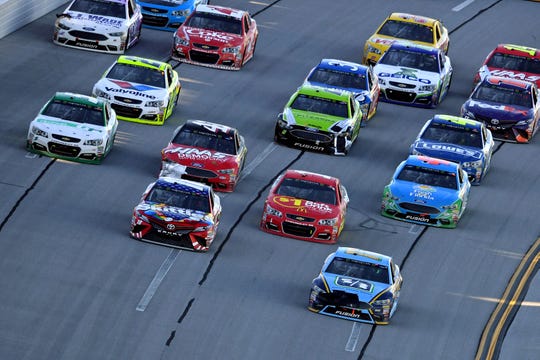Ricky Stenhouse Jr. owns two career MoNASCAR Cup Series victories. They came at Talladega Superspeedway and Daytona International Speedway, tracks where the key to victory rests with the ability to maneuver while the car gets pushed in the aerodynamic draft.
It always helps for drivers to have friends willing to make moves to provide an opponent the push they both need to advance through the field.
Stenhouse hasn’t made too many friends in recent Talladega and Daytona races with an aggressive style that has started a few pileups, but he doesn’t seem all that worried going into Sunday's GEICO 500 at Talladega (2 p.m. ET, Fox).
“It felt like when we won our races at Daytona and Talladega, we didn’t have any friends either,” Stenhouse said about his 2017 wins. “Back in the day, I felt like you had a lot of friends when you had a fast car but now if you have a fast car, they want to shuffle you out so they don't have to contend with you.
“Now going into speedways, a lot of times you can do a lot of things on your own at Talladega and Daytona now.”
Stenhouse then provided the caveat to the race this weekend: “It will be different than what we have been running so it is what it is.”
Ricky Stenhouse Jr., front right, leads the field on the last lap of the 2017 GEICO 500 at Talladega Superspeedway, en route to his first career Cup Series win. (Photo: John David Mercer, USA TODAY Sports)
Drivers have viewed NASCAR’s restrictor-plate races as opportunity events, ones where a vast majority of the field has a shot at the win. Active drivers Stenhouse, Erik Jones, Aric Almirola and David Ragan have combined for seven wins in their careers – all of them coming on what was known as the “restrictor-plate” tracks.
The restrictor plates, from a technical standpoint, are now a thing of the past for races at Daytona and Talladega. But the opportunity remains, while the mystery has increased.
Drivers will have approximately 100 more horsepower at Talladega as well as Daytona in July compared to the 450 they used to have with restrictor plates. When NASCAR decided to use different tapered spacers to lower horsepower from 750 to 550 at tracks longer than 1.3 miles in length for 2019, it opted to use the 550 package at Talladega and Daytona starting with the race this weekend. A tapered spacer acts much like a restrictor plate with holes in the middle to manage engine air flow, but the spacer is 1-inch thick aluminum rather than a one-eighth-inch metal plate.
At a February test with the new specifications at Daytona, the three drivers participating approached 200 mph when running together. NASCAR, which for safety purposes typically doesn’t want speeds much higher than 200 mph at the two tracks, has increased the height of the rear spoiler and the rear height of the car in hopes of decreasing speeds.
“It’s going to be really fast is all I know,” said 2017 Cup champion Martin Truex Jr., who seeks his first win at Talladega. “Really fast. … I really don’t know how the cars are going to drive, how they’re going to handle or what it’s going to be like.
“We’ve never had anywhere near this much horsepower at a restrictor track before. It’s going to be a whole new learning experience, just like every other week this year I suppose.”
WATCH: Wild and memorable crashes at Talladega
The key to success at Talladega in recent years has been slowing an opposing driver by pinching the car door-to-door, impacting that car’s ability to handle.
“I am wondering how the side draft will work … and just how those runs are going to be different,” Stenhosue said. “How you can get different runs on cars and ultimately what you can do when you are out front to maintain the lead.”
Drivers wonder if they could see a return to the tandem racing, where a driver’s front bumper pushes the rear bumper of the opponent for several seconds — a style from several years ago that was panned by many fans because it required one driver significantly helping another.
That could lead to some interesting bedfellows. At the Daytona 500, the Toyota cars – there are only five factory-supported Toyota cars on the circuit with four of them belonging to Joe Gibbs Racing – worked a deal with the four Chevrolet-backed Hendrick drivers to draft with each other in order to combat the Fords of Team Penske (three drivers), Stewart-Haas Racing (four) and Roush Fenway Racing (two).
“Personally, I don’t like how things have kind of evolved with being buddies with certain guys and whatnot,” Hendrick driver Chase Elliott said. “The style of racing that we had, I felt like was good, when everybody was pushing and doing what they had to do.
“Since everybody is not doing that as much anymore and really staying true to their partners and their groups, my feelings wouldn’t be hurt if it changed to that dynamic and looked a little different.”
Bob Pockrass is a FOX Sports reporter. Follow him on Twitter @bobpockrass.
Source: Read Full Article
